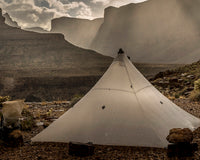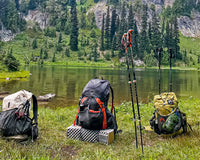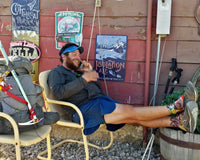I think we can all agree that a successful adventure does not include helicopters and body bags. Preferably, no hospital involvement either. So how do you avoid that disaster scenario? Even better, how do you have a trip that isn’t just “not a disaster” but absolutely amazing? There are a zillion considerations in adventure planning, such as gear, budget, food, etc. Those are important, but take a step back, zoom out.
These six elements of adventure planning encourage you to plan the big picture before narrowing in on decisions like whether or not to cut the handle off your toothbrush or eat nothing but cold bean paste out of a Talenti jar. We’re going to start with the least talked about yet most critical element.
1. Mental/ Emotional Wellness and Group Dynamics

Many of us do wilderness trips for our emotional and social health, not because we’re getting paid (expedition guide, field scientist, wildlife photographer, etc). So take the time to ask yourself these questions, reflect, and then communicate with the relevant people.
- What about this trip is important to me? How do I want to feel during the adventure and after? Sometimes it’s about unstructured time to relax and recharge in nature; other times it’s about challenge and achievement; and there are many other ways to experience an adventure as well. The key is to know what kind of experience is going to satisfy you and to communicate that with others. All your other planning should revolve around what kind of experience you desire.
-
What are my stress triggers on trail? How do I typically respond to stress? On this trip, what is likely to be challenging for me? What are my personal self-soothing strategies? What support can I get from other people?

- How will decisions get made on trail? Will decision making (food, route, timeline, weather, etc.) be done by group consensus, or rotating leadership, or one dominant leader? How will you foster an environment where people feel comfortable speaking up when they are uncomfortable? Very dangerous situations (medically or situationally) can evolve from poor group communication and decision making.
2. Camp Craft

This is the question of how you manage your sleep systems and food systems. It’s also how you manage yourself, your time, and your personal care in camp. Questions to consider include:
- What kind of shelter will you bring? What’s the minimum amount of camp gear and food that will give you the type of experience you want?
- What’s the wind direction, rain run-off situation, sun angle, and the relationship of your camp to the kitchen location?
- How can I make my in-camp systems and activities more efficient? (Being more efficient is safer, cleaner, faster, less chaos, etc; it also means more time and energy for fun and exploration.)
3. Technical Skills

These are the specific skills you need for this adventure. It will highly depend on what adventure you’ve chosen. Some skills are more basic, some are more advanced. Examples are:
- using your camp stove < repairing your camp stove
- setting up your tent < tarp set up in a storm
- paddling in flat water < paddling in swift water
The key is to identify what skills you will need to learn and practice before you’re out there.
4. Location and Navigation

What are the specific challenges of the location for your adventure? This could have to do with the climate, or time of year, or elevation, or terrain. What will be your navigation tools? Do you have the skills to use them? A fancy GPS device isn’t very helpful if you’re not skilled at using it or don’t have the means to keep it charged. If you have map and compass skills in one environment, will you need education and practice in another location; for example, mountain navigation vs on-water navigation?
5. Fitness

Does your athletic ability match the scope of your adventure? This will highly depend on the first element: what kind of experience you are aiming for. If the adventure is quite chill, your current fitness may already be sufficient. Yet, in many cases, specific training for your adventure will increase your chances of safety and success. At the very least, being more fit will mean more energy to enjoy the views and less time gasping and staring at your feet.
6. First Aid and Evacuation Plans

You don’t need to become a wilderness EMT, but you should take the time to make and communicate your safety plan. These are the questions to evaluate and discuss:
- What first aid and medical knowledge does everyone bring to the group? What are the potential needs of the group? Is someone prone to constipation? Eye infections? Allergic reactions? Knee pain? Anxiety attacks? Take the time to honestly and compassionately disclose these personal vulnerabilities, as well as discuss the skills people have to respond to them. This is a critical step in avoiding the preventable.
- What first aid, medical, and rescue supplies do you have? Do the supplies match the skills people have? Don’t carry equipment or medication no one knows how to use properly. Who will carry what?
- What are the specific risks you’re likely to encounter on this trip? What level of risk is each individual comfortable with?
Discuss what are the scenarios you are prepared to treat and manage in the field and how will that affect the group? For example, treating constipation or mild GI distress and allowing for a group layover day.
Discuss what scenarios you would self-evacuate for. These are non-urgent, non-life threatening problems that your group has the skills to handle safely, yet staying in the field is not possible. What are your escape routes? How will things be managed so as to not escalate the situation?
What if you need a rescue? What systems will you put in place in case disaster strikes? It might start at the most basic, making sure at least three people know where you are and when to expect to hear from you. What else will you do to communicate in an emergency? Sometimes it’s as simple as carrying a whistle, sometimes it’s investing in satellite communication and learning how to use it.
Hopefully you’ll never need a rescue, but attending to all six elements of a successful adventure helps avoid disasters of all kinds. Moreover, planning the bigger picture of your trip sets you up to make all the other decisions. Always take the time to define what success looks like for you on this particular adventure.

Kym is the owner of Zest Ed. She coaches recreational endurance adventure athletes to achieve their goals while teaching them about the process of training. Her husband Will coaches outdoorsy people to be more prepared for their wilderness adventures. They are both Wilderness First Responders. When not racing or adventuring, they live in an old apartment in Minneapolis with their kitty Pigeon, where they enjoy books, beer, and bike and run commuting year-round.
Follow them on Instagram @zest_ed_athletics and go to their website (http://zested.net) for a free “What’s Next?” PDF download.
Also, sign up for Kym's “Have Fun. Don’t Die.” class through through the Kula Academy!















